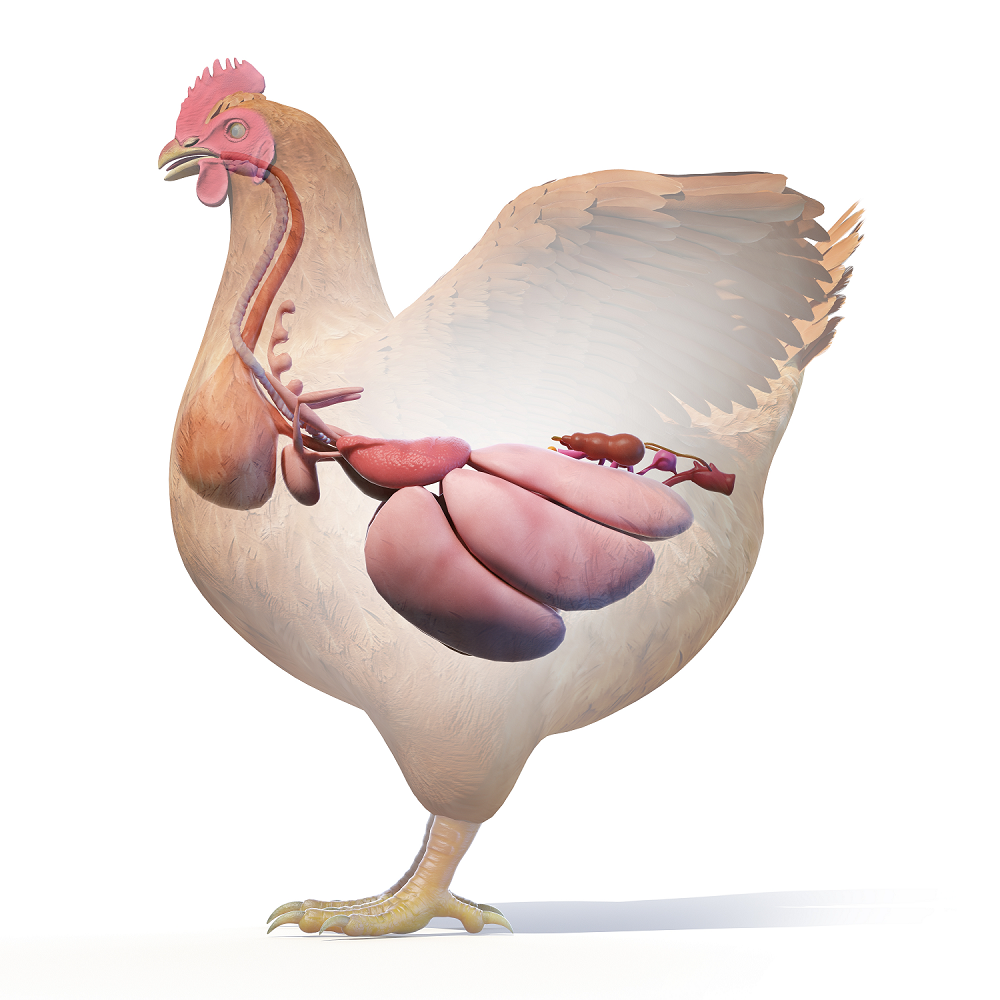Agriculture products contaminated by fungi and molds are often unavoidable and of growing concern, especially since these products frequently have toxic metabolites known as mycotoxins. Mycotoxins are stable compounds that cause a variety of destructive outcomes in poultry, including toxic, teratogenic, mutagenic, and/or carcinogenic effects. In general, under commercial conditions, immunosuppression has been associated with these toxins for decades. The most dangerous mycotoxins in poultry are aflatoxin, ochratoxin, T-2 toxin, HT 2, fumonisin, and deoxynivalenol (DON).

Fumonisin
Aflatoxin
Aflatoxin
Aflatoxin
Fumonisin
T-2 & HT-2
Deoxynivalenol
Ochratoxin
Aflatoxin
T-2 & HT-2
Diacetoxyscirpenol
MAS
T-2 & HT-2
Diacetoxyscirpenol
T-2 & HT-2
Diacetoxyscirpenol
MAS
Ochratoxin
Cyclopiazonic Acid
Fumonisin
Aflatoxin
Aflatoxin
Aflatoxin
Fumonisin
T-2 & HT-2
Deoxynivalenol
Ochratoxin
Aflatoxin
T-2 & HT-2
Diacetoxyscirpenol
MAS
T-2 & HT-2
Diacetoxyscirpenol
T-2 & HT-2
Diacetoxyscirpenol
MAS
Ochratoxin
Cyclopiazonic Acid
Depending on the type and concentration of the mycotoxins present, several adverse clinical signs and lesions can occur. Management practices, genetics, age, sex, and many other factors will also determine the clinical presentation in the affected animals. Different mycotoxins affect different organ systems (urinary, digestive, nervous, reproductive, and immune), making it difficult to establish the exact cause of the health problem(s).

| FUM | DON | T-2 | AFLA | OTA | |
|---|---|---|---|---|---|
| Growth retardation | ++ | + | ++ | +++ | + |
| Hepatic lesion | ++ | + | ++ | +++ | + |
| Kidney damage | +++ | ||||
| Enteritis/intestinal integrity damage | ++ | ++ | +++ | + | |
| Hemorrhages in skin and muscles | + | + | ++ | +++ | |
| Ulcers in oral cavity and tongue | + | +++ | |||
| Gall bladder | + | ++ | +++ | ||
| Immunosuppression | ++ | + | ++ | +++ | + |
| Table: Clinical signs and lesions observed in poultry |
Of production animals studied, poultry is the least affected by lipopolysaccharides (LPS), also known as endotoxins. The theory for this is due to differences in the TLR4 receptor. Utilizing the lock and key concept, the TLR4 activation site responsible for endotoxin action is slightly different from mammals and could partly explain the lower effects of LPS in poultry. Though there is little research, some possible signs of endotoxins in poultry are fatty liver, reduced feed intake, wet litter, and decreased performance: laying rate and shell quality, growth, or reproduction.
In poultry, the target organ of fumonisin B1 is the liver. If fumonisin B1 is suspected, the presence of toxicity can be determined by measuring the metabolites of blood lipids that serve as identification markers. Another method to detect for fumonisin B1 in poultry is by evaluating gross lesions (macroscopic).
Easily detected in commercial feed, and often used as a marker to indicate contamination of mycotoxins from the Fusarium group, zearalenone (ZEA) is known to affect the immune system. Scientific publications have established its effects on the reproductive tract (oviduct, ovaries, and testicles) when high concentrations of ZEA were added to the diet. Despite this research, it is difficult to establish the impact of ZEA in commercial production.
A group of mycotoxins produced mainly by molds from the Fusarium genus are included under this classification because they share a similar chemical structure. There are four types of trichothecene (A, B, C, D), with type A (T2 toxin, DAS) and type B (DON) being the most important in poultry.
Commonly known as DON, deoxynivalenol affects intestinal integrity and results in a degree of intestinal damage to cause watery feces and feed passage. For years, it was not considered an important mycotoxin for poultry. However, in the last decade, its negative impact has been demonstrated.
A metabolite of T2, HT-2 is produced in the field while the plants are growing. Similar to animals, plants try to avoid toxic substances (e.g. T2 toxin), so they metabolize T2 into a new metabolite, HT-2 toxin. In the plant’s attempt to reduce the toxicity of T2 for itself, these metabolites can be more, less, or equally toxic as the original mycotoxin for animals.
Characterized by necrosis of the oral mucosa and damage to the intestinal epithelium, the target organ of these mycotoxins is the oral cavity. Often first observed in the oral mucosa, further evaluation will frequently find lesions in the intestines and gizzard.
Mainly produced by P. viridicatum and A. ochraceus, ochratoxin (OTA) is considered one of the most toxic mycotoxins in poultry. The target organ is the kidneys which, when damaged by OTA, can show urate deposits and organ enlargement.
Produced by several species of Aspergillus, Penicillium, and Byssochlamys, patulin shows low toxicity to poultry. Therefore, it is not analyzed regularly in commercial poultry rations, and clinical cases are not frequently detected.
Produced by Aspergillus flavus, A. parasiticus, and Penicillium spp., Aflatoxins are classified as highly carcinogenic and toxic mycotoxins whose target organ is the liver. Commonly associated with general immunosuppression and other clinical signs, it can be complicated to make the correct diagnosis. In general, of the poultry species, duckling and turkey poults are the most sensitive to aflatoxin. Although chickens are more resistant to this toxin, severe effects can be present in young and mature birds.
Produced by A. flavus—the same mold responsible for aflatoxin production—this toxin can affect the proventriculus, gizzard, and other gastrointestinal tract organs. The proventriculus is the main target organ for this mycotoxin.
Produced by Claviceps purpurea, ergots are responsible for ergotism poisoning. If birds are affected, there will be necrosis as well as the detection of vesicles and ulcers on the beak, combs, wattles, and toes of broilers and layers. Globally, ergotism is not reported as a common problem, and it typically is not included in the screening test routinely performed in feed mills that manufacture poultry feed.

Would you like to be kept informed of our latest developments? Register here and stay up to date.
"*" indicates required fields
| Cookie | Duration | Description |
|---|---|---|
| cookielawinfo-checkbox-analytics | 11 months | This cookie is set by GDPR Cookie Consent plugin. The cookie is used to store the user consent for the cookies in the category "Analytics". |
| cookielawinfo-checkbox-functional | 11 months | The cookie is set by GDPR cookie consent to record the user consent for the cookies in the category "Functional". |
| cookielawinfo-checkbox-necessary | 11 months | This cookie is set by GDPR Cookie Consent plugin. The cookies is used to store the user consent for the cookies in the category "Necessary". |
| cookielawinfo-checkbox-others | 11 months | This cookie is set by GDPR Cookie Consent plugin. The cookie is used to store the user consent for the cookies in the category "Other. |
| cookielawinfo-checkbox-performance | 11 months | This cookie is set by GDPR Cookie Consent plugin. The cookie is used to store the user consent for the cookies in the category "Performance". |
| viewed_cookie_policy | 11 months | The cookie is set by the GDPR Cookie Consent plugin and is used to store whether or not user has consented to the use of cookies. It does not store any personal data. |
